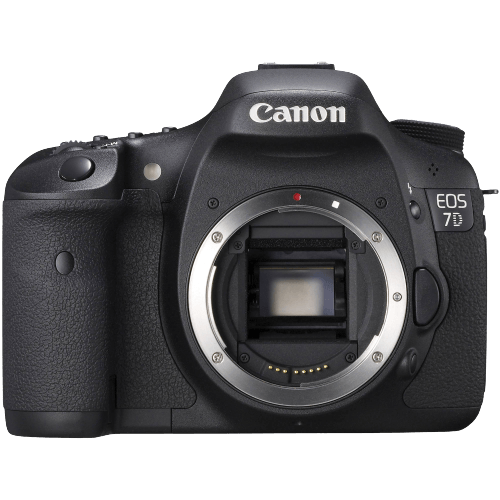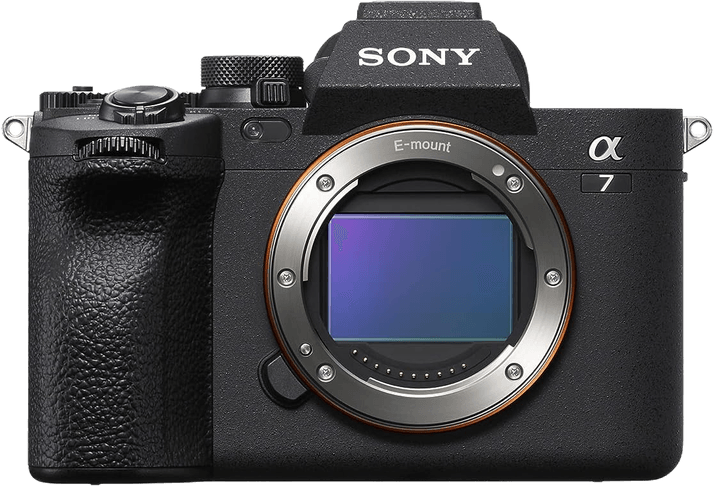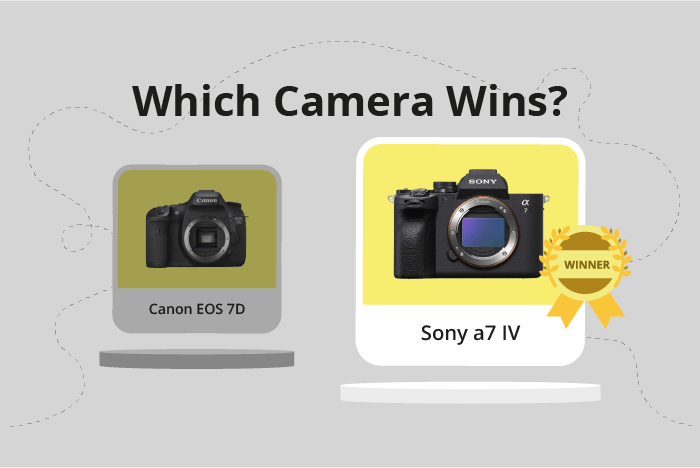Canon EOS 7D vs Sony a7 IV Comparison
Canon EOS 7D

Sony a7 IV

The Sony a7 IV outperforms the Canon EOS 7D with a score of 84/100, compared to the Canon’s 45/100. Both cameras share common features such as launch price, announcement date, and release year. However, the Sony a7 IV’s mirrorless design offers a more compact and lightweight build, measuring 131 x 96 x 80mm and weighing 659g. In contrast, the Canon EOS 7D is a bulkier DSLR, measuring 148 x 111 x 74mm and weighing 860g.
The Sony a7 IV’s higher score reflects its superior performance and advanced technology. Its mirrorless design allows for a more portable and user-friendly experience. On the other hand, the Canon EOS 7D’s DSLR design provides a more traditional photography experience and might appeal to those who prefer a heftier camera.
Taking all these factors into account, the Sony a7 IV emerges as a clear winner for its compact design, lighter weight, and higher performance score. The Canon EOS 7D, while not as highly rated, may still hold appeal for those loyal to DSLR cameras.
Canon EOS 7D vs Sony a7 IV Overview and Optics
The Sony a7 IV outperforms the Canon EOS 7D in optics, scoring 85 out of 100 compared to the 7D’s 43. Both cameras share similarities in their specifications, such as having a CMOS sensor type and a shooting speed of 8 for the 7D and 10 for the a7 IV. However, the differences in specs contribute to the higher score of the Sony a7 IV.
The Sony a7 IV has a significant advantage with its 33-megapixel resolution, compared to the Canon 7D’s 18 megapixels. This increased resolution allows for more detailed images. Additionally, the a7 IV features a superior processor, the Bionz XR, which results in faster image processing and improved performance. The Sony a7 IV also has a higher DXOMARK sensor score of 97, indicating better image quality compared to the 7D’s score of 66.
Another notable difference is the sensor size. The Sony a7 IV boasts a full-frame sensor, while the Canon 7D has an APS-C sensor. The full-frame sensor provides better low-light performance and a shallower depth of field. Furthermore, the Sony a7 IV has built-in image stabilization, which the Canon 7D lacks, making it easier to capture sharp images in various shooting conditions.
The Canon EOS 7D, however, has the advantage of the Canon EF-S lens mount, which offers a wider selection of lenses than the Sony FE mount. This could be beneficial to photographers who already have a collection of Canon lenses or prefer the Canon lens lineup.
Considering the specifications, the Sony a7 IV stands out as the better option in terms of optics, with its higher resolution, better sensor performance, and image stabilization. The Canon EOS 7D may still appeal to those who prefer the Canon lens ecosystem, but its overall performance in optics falls short compared to the Sony a7 IV.
Canon EOS 7D vs Sony a7 IV Video Performance
The Sony a7 IV outperforms the Canon EOS 7D in video capabilities, with a video score of 91/100 compared to the 7D’s 43/100. This significant difference highlights the superior video performance of the a7 IV.
Both cameras share some common specs, such as the ability to record video. However, the Sony a7 IV offers higher video resolution, with 4K (3840 x 2160) compared to the Canon EOS 7D’s Full HD (1920 x 1080). This increased resolution provides sharper and more detailed video footage. Additionally, the a7 IV has a higher maximum video frame rate of 120fps, compared to the 7D’s 30fps. This allows for smoother video playback and the option to create impressive slow-motion footage. The Sony a7 IV also includes built-in time-lapse functionality, which the Canon EOS 7D lacks.
While the Canon EOS 7D falls behind in video capabilities, it still offers Full HD video recording, which may be sufficient for casual users or those prioritizing photography over videography. However, it is clear that the Sony a7 IV is the superior choice for those seeking advanced video features and performance.
Considering the substantial difference in video scores and the advanced features of the Sony a7 IV, it is evident that the a7 IV is the better option for individuals focused on video capabilities. The Canon EOS 7D may be a suitable choice for those who require basic video functionality, but the Sony a7 IV is the clear winner in this comparison.
Canon EOS 7D vs Sony a7 IV Features and Benefits
The Sony a7 IV outperforms the Canon EOS 7D, scoring 83 points in features compared to the 7D’s 54 points. Both cameras share some specifications, such as a 3-inch screen size and lack of GPS. However, the a7 IV excels in various aspects, making it a superior choice for photographers seeking advanced features.
The Sony a7 IV’s screen resolution is higher at 1,040,000 dots, compared to the Canon 7D’s 920,000 dots. This higher resolution provides a sharper and clearer display, enhancing the user experience. Additionally, the a7 IV has a touchscreen and a flip screen, making it more versatile and user-friendly, while the 7D lacks these features.
The a7 IV offers wireless connectivity options, including Wi-Fi and Bluetooth, enabling seamless transfer of photos and remote control of the camera. The Canon 7D does not have these connectivity options, limiting its usability in this regard.
Despite the Canon 7D’s lower feature score, it is worth noting that it still delivers solid performance and image quality. For photographers who prioritize other aspects, such as optics and video capabilities, the 7D may still be a suitable choice.
Ultimately, the Sony a7 IV’s higher feature score results from its advanced specifications, such as a higher screen resolution, touchscreen, flip screen, Wi-Fi, and Bluetooth. These features make it the better option for those seeking a more versatile and user-friendly camera. On the other hand, the Canon EOS 7D remains a viable option for photographers who prioritize other aspects of camera performance.
Canon EOS 7D vs Sony a7 IV Storage and Battery
The Sony a7 IV outperforms the Canon EOS 7D in storage and battery, scoring 76/100 compared to the Canon’s 35/100. Both cameras differ in memory card slots, battery life, and USB charging capabilities.
The Sony a7 IV has two memory card slots, accepting CFexpress Type A and SD (UHS-II compatible) cards, while the Canon EOS 7D has one slot for Compact Flash (Type I or II), UDMA, and Microdrive cards. The Sony’s dual slots provide more flexibility and storage capacity.
In terms of battery life, the Canon EOS 7D is superior with 800 shots, using an LP-E6 battery. The Sony a7 IV offers 580 shots with its NP-FZ100 battery. However, the Sony a7 IV compensates with USB charging, enabling users to charge the camera on-the-go, a feature absent in the Canon EOS 7D.
Considering these factors, the Sony a7 IV has an advantage in storage options and charging flexibility, while the Canon EOS 7D offers longer battery life per charge.
Canon EOS 7D vs Sony a7 IV – Our Verdict
Are you still undecided about which camera is right for you? Have a look at these popular comparisons that feature the Canon EOS 7D or the Sony a7 IV:

